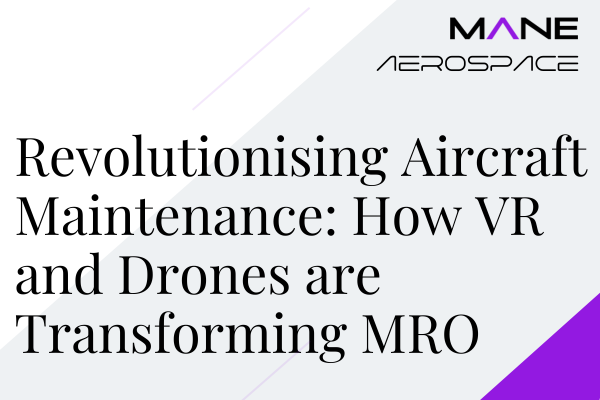
Revolutionising Aircraft Maintenance: How VR and Drones are Transforming MRO
21 Aug, 20245 minsRevolutionising Aircraft Maintenance: How VR and Drones are Transforming MROThe aviation mai...

Revolutionising Aircraft Maintenance: How VR and Drones are Transforming MRO
The aviation maintenance, repair and overhaul (MRO) industry is undergoing a technological revolution, with virtual reality (VR) and drones at the forefront. These cutting-edge technologies are changing how maintenance tasks are performed, technicians are trained, and inspections are conducted. Let's explore how MRO companies are leveraging VR and drones, the key benefits, and the impact on workforce development.
Virtual Reality in MRO Training and Operations
Virtual reality is proving to be a game-changer for MRO training and complex maintenance procedures. The immersive nature of VR allows technicians to gain hands-on experience in a safe, controlled environment before working on actual aircraft.
Enhanced Training Effectiveness
Studies have shown that VR training can be significantly more effective than traditional methods, particularly for developing spatial awareness, workload management, decision-making and problem-solving skills in maintenance scenarios. For instance, a study conducted by Boeing found that maintenance trainees who used VR were 30% more successful in their first hands-on attempts and completed their tasks 30% faster compared to those who used traditional 2D drawings and manuals.
Airbus has been a pioneer in this area, developing VR training modules for a wide range of maintenance procedures. Their VR-based training for the A350 XWB, for example, allows technicians to practise complex tasks such as landing gear replacement in a fully immersive environment. Airbus reports that this approach has led to a 25% reduction in training time and a 40% improvement in task completion accuracy.
Realistic Maintenance Simulations
VR allows technicians to practise complex procedures on virtual 3D models of aircraft systems and components. This capability is particularly valuable for simulating rare faults and emergency scenarios that are difficult or impossible to replicate in real life.
For example, Lufthansa Technik has developed a VR-based training programme for engine maintenance. Technicians can disassemble and reassemble virtual engines, practise complex repair procedures, and even simulate emergency situations like engine fires. This approach not only enhances safety but also reduces the need for costly physical mock-ups.
Remote Collaboration
VR and augmented reality (AR) technologies are enabling maintenance experts to remotely assist technicians in the field, a capability that has proven invaluable during the global pandemic. Lufthansa Technik implemented a solution called 'Virtual Table Inspection' that allows remote experts to guide on-site technicians through complex inspections and repairs.
By using VR headsets and AR overlays, technicians can share their view with remote specialists who can then provide real-time guidance. This approach has not only reduced travel costs but also improved response times for challenging maintenance issues. Lufthansa Technik reports that this system has led to a 50% reduction in AOG (Aircraft on Ground) time for certain types of repairs.
Drones Revolutionising Aircraft Inspections
Unmanned aerial vehicles, commonly known as drones, equipped with high-resolution cameras and sensors are transforming how aircraft inspections are conducted. These flying robots are capable of accessing hard-to-reach areas of an aircraft quickly and safely, providing detailed imagery for analysis.
Faster and Safer Inspections
Traditional aircraft inspections are time-consuming and can pose safety risks to technicians who need to use ladders, lifts, and scaffolding to access various parts of the aircraft. Drones are changing this paradigm dramatically.
EasyJet, in collaboration with Blue Bear Systems Research, has been testing drone inspections since 2015. Their trials have shown that a drone can complete an aircraft exterior inspection in about 2 hours, compared to the 2 full working days typically required for a manual inspection. This represents a time saving of approximately 75%, which can significantly reduce aircraft downtime.
Moreover, the use of drones eliminates the need for technicians to work at heights or in confined spaces, thereby reducing the risk of workplace injuries. According to the UK's Health and Safety Executive, falls from height accounted for 25% of worker fatalities in 2020/21. By using drones for high-level inspections, MRO companies can significantly mitigate this risk.
Enhanced Defect Detection
Drones are not just faster; they're also proving to be more accurate in detecting defects. Equipped with high-resolution and thermal imaging cameras, drones can detect minute cracks, corrosion, and other defects that might be missed by the human eye.
Airbus has developed an advanced drone inspection system that uses AI-powered image analysis to automatically identify and flag potential issues. In trials, this system demonstrated a 95% accuracy rate in detecting structural defects, surpassing the industry average of 85% for manual inspections.
British Airways has also embraced drone technology for aircraft inspections. In a recent trial at its maintenance base in Cardiff, BA used drones to inspect a Boeing 787 Dreamliner. The inspection, which would typically take more than 12 hours, was completed in just 2 hours. Moreover, the drones were able to capture over 150 high-definition images of the aircraft, providing an unprecedented level of detail for analysis.
Reduced Aircraft Downtime
The speed and accuracy of drone inspections translate directly into reduced aircraft downtime. For airlines, every hour an aircraft spends on the ground for maintenance represents lost revenue. By accelerating the inspection process, drones are helping to maximise aircraft utilisation.
Ryanair, Europe's largest low-cost carrier, has reported that the implementation of drone inspections has reduced their aircraft turnaround times by up to 30% for routine maintenance checks. This improvement has allowed them to schedule more flights and increase overall fleet efficiency.
Impact on MRO Workforce and Hiring
The adoption of VR and drone technologies is reshaping workforce needs in the MRO industry. While these technologies are not replacing human workers, they are changing the skills required and creating new job roles.
New Skill Requirements
MRO companies are increasingly seeking technicians with skills that go beyond traditional aircraft maintenance. There's a growing demand for expertise in:
- Virtual and augmented reality systems
- Drone piloting and maintenance
- Data analysis and AI/machine learning
- Software development
British Airways, for example, has launched a new training programme in partnership with the University of Exeter to upskill its maintenance technicians in these areas. The airline aims to have 30% of its MRO workforce trained in advanced digital technologies by 2025.
Changing Job Roles
As VR and drone technologies become more prevalent, new positions are emerging within MRO organisations. Roles such as VR training instructors, drone inspection specialists, and data scientists for predictive maintenance are becoming increasingly common.
Rolls-Royce, a leading aircraft engine manufacturer, has created a new department dedicated to digital technologies in MRO. This team, which includes VR developers, drone pilots, and data analysts, has grown from just 5 members in 2018 to over 50 in 2023, highlighting the rapid growth in demand for these skills.
Attracting Tech-Savvy Talent
The use of cutting-edge technologies is helping to attract younger, tech-oriented workers to the MRO field. This is crucial for an industry that has traditionally struggled with an ageing workforce.
A survey conducted by Aviation Week Network in 2022 found that MRO companies using advanced technologies like VR and drones reported a 40% increase in job applications from candidates under 30 compared to those using traditional methods.
Looking Ahead
As VR and drone technologies continue to mature, we can expect to see even greater integration into MRO operations. Future developments may include fully autonomous drone inspections, VR-based certification programmes for maintenance procedures, and AI-powered decision support systems for maintenance planning.
The potential for these technologies to improve efficiency, quality, and safety in aircraft maintenance is immense. A report by Frost & Sullivan predicts that by 2025, the use of VR and drones in MRO could lead to:
- A 50% reduction in training time for new maintenance technicians
- A 30% improvement in first-time fix rates for complex repairs
- A 40% reduction in inspection times for large commercial aircraft
MRO providers that embrace these technologies now will be well-positioned to reap these benefits while attracting the skilled workforce needed for the future of aircraft maintenance.
In conclusion, the integration of VR and drone technologies in MRO is not just a passing trend, but a fundamental shift in how aircraft maintenance is performed. By leveraging these innovations, the MRO industry is taking flight into a new era - one that promises safer skies, more reliable aircraft, and exciting opportunities for the next generation of aviation maintenance professionals. As we look to the future, it's clear that the sky is no longer the limit for MRO technology.


